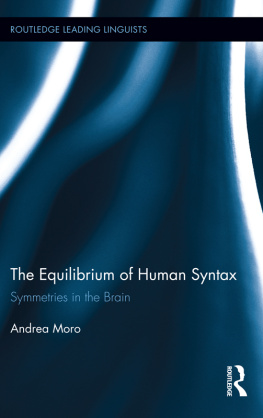Moro - The equilibrium of human syntax : symmetries in the brain
Here you can read online Moro - The equilibrium of human syntax : symmetries in the brain full text of the book (entire story) in english for free. Download pdf and epub, get meaning, cover and reviews about this ebook. City: New York, year: 2013, publisher: Routledge, genre: Romance novel. Description of the work, (preface) as well as reviews are available. Best literature library LitArk.com created for fans of good reading and offers a wide selection of genres:
Romance novel
Science fiction
Adventure
Detective
Science
History
Home and family
Prose
Art
Politics
Computer
Non-fiction
Religion
Business
Children
Humor
Choose a favorite category and find really read worthwhile books. Enjoy immersion in the world of imagination, feel the emotions of the characters or learn something new for yourself, make an fascinating discovery.
- Book:The equilibrium of human syntax : symmetries in the brain
- Author:
- Publisher:Routledge
- Genre:
- Year:2013
- City:New York
- Rating:4 / 5
- Favourites:Add to favourites
- Your mark:
- 80
- 1
- 2
- 3
- 4
- 5
The equilibrium of human syntax : symmetries in the brain: summary, description and annotation
We offer to read an annotation, description, summary or preface (depends on what the author of the book "The equilibrium of human syntax : symmetries in the brain" wrote himself). If you haven't found the necessary information about the book — write in the comments, we will try to find it.
Moro: author's other books
Who wrote The equilibrium of human syntax : symmetries in the brain? Find out the surname, the name of the author of the book and a list of all author's works by series.
The equilibrium of human syntax : symmetries in the brain — read online for free the complete book (whole text) full work
Below is the text of the book, divided by pages. System saving the place of the last page read, allows you to conveniently read the book "The equilibrium of human syntax : symmetries in the brain" online for free, without having to search again every time where you left off. Put a bookmark, and you can go to the page where you finished reading at any time.
Font size:
Interval:
Bookmark:
The Equilibrium of Human Syntax
This book assembles a collection of Andrea Moros papers in two different domains: formal syntax and neurolinguistics. Here Moro shares evidence that the two fields are becoming more and more interconnected and that the new fascinating questions and empirical results in the latter field cannot be obtained without the theoretical base provided by the former.
provides the original sources of some innovative and pioneering experiments based on neuroimaging techniques (focusing on the biological nature of recursion and the interpretation of negative sentences).
Moro concludes with an assessment of the impact of these perspectives on the theory of the evolution of language. The leading and pervasive idea unifying all the arguments developed here is the role of symmetry (breaking) in syntax and in the relationship between language and the human brain.
Andrea Moro is Professor of General Linguistics and Director of the Center for Neurolinguistics and Theoretical Syntax (Ne.T.S.) at the Institute for Advanced Study IUSSPavia, Italy.
Routledge Leading Linguists
Edited by Carlos P. Otero, University of California, Los Angeles, USA
1 Partitions and Atoms of Clause Structure
Subjects, Agreement, Case and Clitics
Dominique Sportiche
2 The Syntax of Specifiers and Heads
Collected Essays of Hilda J. Koopman
Hilda J. Koopman
3 Configurations of Sentential Complementation
Perspectives from Romance Languages
Johan Rooryck
4 Essays in Syntactic Theory
Samuel David Epstein
5 Comparative Syntax and Language Acquisition
Luigi Rizzi
6 Minimalist Investigations in Linguistic Theory
Howard Lasnik
7 Derivations
Exploring the Dynamics of Syntax
Juan Uriagereka
8 Towards an Elegant Syntax
Michael Brody
9 Generative Grammar
Theory and its History
Robert Freidin
10 Theoretical Comparative Syntax
Studies in Macroparameters
Naoki Fukui
11 A Unification of Morphology and Syntax
Investigations into Romance and Albanian Dialects
M. Rita Manzini and Leonardo M. Savoia
12 Aspects of the Syntax of Agreement
Cedric Boeckx
13 Structures and Strategies
Adriana Belletti
14 Between Syntax and Semantics
C. T. James Huang
15 Regimes of Derivation in Syntax and Morphology
Edwin Williams
16 Typological Studies
Word Order and Relative Clauses
Guglielmo Cinque
17 Case, Argument Structure, and Word Order
Shigeru Miyagawa
18 The Equilibrium of Human Syntax
Symmetries in the Brain
Andrea Moro
The Equilibrium of Human Syntax
Symmetries in the Brain
Andrea Moro

First published 2013
by Routledge
711 Third Avenue, New York, NY 10017
Simultaneously published in the UK
by Routledge
2 Park Square, Milton Park, Abingdon, Oxon OX14 4RN
Routledge is an imprint of the Taylor & Francis Group, an informa business
2013 Taylor & Francis
The right of Andrea Moro to be identified as author of this work has been asserted by him in accordance with sections 77 and 78 of the Copyright, Designs and Patents Act 1988.
All rights reserved. No part of this book may be reprinted or reproduced or utilised in any form or by any electronic, mechanical, or other means, now known or hereafter invented, including photocopying and recording, or in any information storage or retrieval system, without permission in writing from the publishers.
Trademark Notice: Product or corporate names may be trademarks or registered trademarks, and are used only for identification and explanation without intent to infringe.
Library of Congress Cataloging in Publication Data
Moro, Andrea.
The equilibrium of human syntax : symmetries in the brain / by Andrea Moro.
p. cm. (Routledge Leading Linguists; 18)
Includes bibliographical references and index.
1. Grammar, Comparative and generalSyntax. 2. Neurolinguistics.
I. Title.
P291.M595 2012
415dc23
2012017730
ISBN: 978-0-415-63967-5 (hbk)
I would like to express my deep gratitude to my maestri, i migliori fabbri: Robert Berwick, Stefano Cappa, Noam Chomsky, Gennaro Chierchia, Guglielmo Cinque, Giorgio Graffi, Richard Kayne, Giuseppe Longobardi, Jacques Mehler, Massimo Piattelli-Palmarini and Luigi Rizzi.
A special thank to Carlos Otero for offering me such a great honor as publishing this collection in the Series he is editing.
Original Publication Details
1988 Toward a unified theory of copular sentences, Rivista di Grammatica Generativa, 13, pp. 81110; translated by the author from the original Per una teoria unificata delle frasi copulari, by permission from the Rivista di Grammatica Generativa, CLESP, Padova.
1993 Heads as antecedents: A brief history of the ECP, Lingua e Stile, 28, pp. 3157, by permission from Lingua e Stile, Il Mulino, Bologna.
1997 Dynamic antisymmetry: Movement as a symmetry-breaking phenomenon, Studia Linguistica, 51, pp. 5076, by permission from Studia Linguistica, Blackwell Publishers, Oxford.
1997 A short history of be, appendix of The raising of predicates: Predicative noun phrases and the theory of clause structure, Cambridge Studies in Linguistics Series, by permission from Cambridge University Press, Cambridge.
2000 Elements of copular syntax, appendix of Dynamic antisymmetry: Movement as a symmetry breaking phenomenon, Linguistic Inquiry Monograph Series, 38, pp. 103126, by permission from MIT Press, Cambridge, Massachusetts.
2001 A. Moro, M. Tettamanti, D. Perani, C. Donati, S. F. Cappa, F. Fazio. Syntax and the brain: Disentangling grammar by selective anomalies, NeuroImage, 13, January, Academic Press, Chicago, pp. 110118, by permission from Neuroimage, Elsevier, Amsterdam.
2002 M. Tettamanti, H. Alkadhi, A. Moro, D. Perani, S. Kollias, D. Weniger. Neural correlates for the acquisition of natural language syntax, NeuroImage, 17: 700709, by permission from Neuroimage, Elsevier, Amsterdam.
2003a Notes on vocative case: A case study in clause structure, in Josep Quer, Jan Schroten, Petra Sleeman, Els Verheugd (eds.), Romance languages and linguistic theory 2001, pp. 251264, by permission from John Benjamins Publishing Company, Amsterdam.
2003b M. Musso, A. Moro, V. Glauche, M. Rijntjes, J. Reichenbach, C. Bchel, C. Weiller. Brocas area and the language instinct, Nature neuroscience, 6, 774781, by permission from Nature Neuroscience, New York.
2004 Linear compression as a trigger for movement, in H. van Riemsdijk, A. Breitbarth (eds.), Triggers, pp. 387429, by permission from Mouton de Gruyter, Berlin.
2006a Copular sentences, in The Blackwell Companion to syntax, 2, 123, M. Everaert, H. van Riemsdik, H. (eds.), Blackwell, by permission from John Wiley & Sons Ltd.
2006b Existential sentences and expletive there, in The Blackwell companion to syntax, pp. 210236, vol. II, M. Everaert, H. van Riemsdik (eds.), Blackwell, Oxford, by permission from John Wiley & Sons Ltd.
2007 Jubin Abutalebi, Simona M Brambati, Jean-Marie Annoni, Andrea Moro, Stefano F. Cappa, Daniela Perani, Auditory perception of language switches: Controlled versus automatic processing as revealed by event-related fMRI, Journal of Neuroscience, 27(50): 1376213769, by permission from Journal of Neuroscience
Next pageFont size:
Interval:
Bookmark:
Similar books «The equilibrium of human syntax : symmetries in the brain»
Look at similar books to The equilibrium of human syntax : symmetries in the brain. We have selected literature similar in name and meaning in the hope of providing readers with more options to find new, interesting, not yet read works.
Discussion, reviews of the book The equilibrium of human syntax : symmetries in the brain and just readers' own opinions. Leave your comments, write what you think about the work, its meaning or the main characters. Specify what exactly you liked and what you didn't like, and why you think so.










